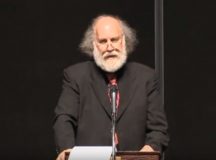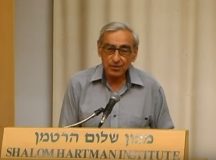One-State is a Trap for Two Peoples in Palestine and Israel
Editorial introduction to the Symposium: Perry Anderson’s long essay, ‘The House of Zion’, was published in the November-December 2015 issue of New Left Review, the ‘flagship journal of the Western Left’. Fathom invited Shany Mor, Cary Nelson, John Strawson, Michael Walzer, Mitchell Cohen and Einat Wilf to respond to Anderson’s essay.
Available online, and given the status of an NLR ‘Editorial’, it was the Marxist equivalent of a Papal edict. Anderson was the journal’s long-time editor, and is perhaps the most gifted intellectual historian of his time, author of Lineages of the Absolutist State, Passages from Antiquity to Feudalism, Considerations on Western Marxism, English Questions, The Origins of Postmodernity, and more. In this outing, Anderson serves as episcopus servus servorum Dei, or, the servant of the servants of God (in this case a secular God). Over 14,000 words, he excommunicates the two-state solution to the Israeli-Palestinian conflict and anoints an alternative: ‘the demand for one state is now the best Palestinian option available.’
Anderson’s essay is a summa of the thinking of the Left that has lost its way on the question of Israel. For one thing, his proclamation proceeds untouched by the categories with which classical Marxism has traditionally approached unresolved national questions: ‘internationalism’, ‘chauvinism’, ‘peace between nations’, ‘people’, ‘class’, ‘consistent democracy’, ‘the right to national self-determination’, ‘minority rights’, and ‘federalism’. Instead he prefers the decidedly non-Marxist categories of ‘the Arab states’, ‘their traditional enemy’, the homeland’, ‘the West’, ‘Arab turbulence’, ‘the Zionists’, ‘the Resistance’ and ‘the New World Order’.
Anderson’s dream that the ‘strategic emplacements’ of the Arab states will end the existence of Israel is a far cry from the Marxism of Lenin, who believed national self-determination and consistent democracy was the way to ‘clear the decks for the class struggle’; from the sophisticated discussions of the national question, the rights of peoples, and the mechanics of federalism of the first four congresses of the Communist Third International; and from Trotsky’s late support of the Jewish people’s right to survival as a nation and to live as a ‘compact mass’. In place of all that, conspiracism is passed off as sophisticated geopolitics, class politics is bracketed ‘for the duration’, and fascistic political forces are embraced as ‘the resistance’.
*
John Strawson argues that Perry Anderson’s new position on Israel and Palestine offers only an abstract and rhetorical revolutionism that is unable to advance mutual recognition between the two peoples or secure their right to self-determination.
Perry Anderson announced a new position on the Palestinian-Israeli conflict in his 2015 editorial in New Left Review as he came out in favour of the one-state solution..[1] This marked a major change, as he had previously argued that ‘such a solution was always bound to founder on the ‘reality of two antagonistic ethnic nationalisms, each entitled to their claim of self-determination.’[2] In 2015 he declared that ‘the demand for one state is now the best Palestinian option available.’[3] Whereas in 2001 he was in favour of ‘just partition’[4] in 2015 he approved of Joel Kovel’s formulation that that a two-state solution is a ‘code word’ for ‘the continued aggrandizement of the Jewish state.’[5] The Anderson of 2015 appeared no longer sensitive to the existence of two national movements and he abandoned the principle of self-determination, declaring ‘it is too late for that today.’[6] Instead, he has embraced a body of literature which proposes a single state for Palestine, the so-called one-state Solution.
This literature makes the case for a one-state solution from disparate positions. However, the tendency of them all is to argue for the one-state solution on the grounds of the conjunctural failure of Oslo; in particular the massive growth in numbers of Israeli settlers, the associated road system, and the direct Israeli control over about 40 per cent of West Bank land. All this is conceptualised as irreversible and to have made the creation of a Palestinian state unviable. A typical example is a book lauded by Anderson, Ali Abunimah’s One Country, in which the author wrote, ‘Given the current state of affairs, we are further away from achieving the two-state solution than ever’[7]. As a result he argued that Palestinians have ‘started to talk once again about binationalism – the creation of a single democratic state for Israelis and Palestinians – as the only viable solution.’[8] Virginia Tilley, in her 2005 book The One State-Solution, argued that the ‘two-state solution has been eliminated as a practical solution,’ as ‘Jewish settlements have carved Palestinian territory into a vestige too small to sustain a viable national society.’ She continued, ‘even a decade ago’ a viable Palestine state ‘was imaginable.’[9]
Getting Zionism wrong
These formulations create the false impression that there had been a long-term acceptance of a two-state solution, which has now sadly become unviable, causing a ‘return’ to the discussion of binationalism and the creation of one state. In fact, on closer inspection that is simply not the case, as many of these authors have never been committed to the two-state solution. Indeed, when Tilley referred to the UN partition plan, she explained that the ‘two-state solution has always entailed a myriad of difficulties.’[10] Ghada Karmi’s Married to Another Man is in fact a sustained argument against the conception that Jews have any national identity. [11]
Abunimah’s suggestion that there has been a return to the discussion of binationalism amongst Palestinians is curious, as it was never part of Palestinian national discourse until the 21st century. It was only within Zionism that such views had currency. In other words, binationalism is new for the Palestinians, but not for the Jews. Anderson’s treatment of binationalism is influenced by his reading of Benny Morris’s One State, Two States.[12] Following Morris’s lead, he writes that there were only ‘tiny minorities in the Yishuv that argued for a bi-national state.’[13] However, this is misleading. At the 12th Zionist Congress held in 1921 a resolution was adopted which resolved ‘the determination of the Jewish people to live with the Arab people on terms of unity and mutual respect, and together with them to make the common home into a flourishing community, the upbuilding of which may assure each people an undisturbed national development.’[14] This resolution indicates that binationalism was a consensus position amongst Zionists at the beginning of the British control of Palestine. It can be argued that in the 1920s and 1930s the dominant discourses in the Zionist movement projected a Palestine that would be run along federal, confederal or binational lines. Hashomer Hatzair, the main force in the Kibbutz movement argued for a bi-national state right up until 1947, with each people envisaged as self-governing within the framework of one country. Indeed, the party founded partly by Hashomer Hatzair, Mapam (the United Workers Party), won the second largest number of seats in the first Knesset.
However, such historical facts are inconvenient to Anderson, who seeks to construct a ‘mainstream’ Zionism that ‘sought a mono-ethnic state.’ Since 2001 Morris has indeed tried to argue that it is in the logic of Zionism to seek such a mono-ethnic state, but he can find no documents in the Zionist archives which prove this; he is reliant on a few individuals, diary entries, off-hand comments, and even gestures to make his case.[15] Anderson is ill-advised to follow in Morris’s tracks. Not a single Zionist or Jewish organisation making representations to the United Nations Special Committee on Palestine (UNSCOP) in 1947 advocated a ‘mono-ethnic state.’ It appears in no programme of the Zionist movement or significant faction of it. Anderson, usually such a subtle theorist whose work is full of historical insights,[16] has adopted a crude, ahistorical and essentialist view of Zionism.
Getting the Palestinian national movement wrong
In Anderson’s account, the Palestinian leadership has betrayed the Palestinian people. The Fatah leadership, under both Arafat and Abbas, is seen by him as the bulwark against a Palestinian revolution; they are the men who betrayed the First Intifada by signing the Oslo Accords, and who collaborated with the Israeli suppression of the Second Intifada.[17] In his account, the accumulation of betrayals by the Palestinian leadership and the aggressive colonisation of the West Bank by Israel have combined to exclude the possibility of a two-state solution today. The Palestinian Authority (PA) is viewed as a ‘co-production of the West and Israel, whose primary function was not to embody but to contain resistance to Zionism.’[18]
However, what Anderson does not consider is the real-world choices facing the PLO in the period following the end of the Cold War and during the continuing First Intifada until 1993. The Madrid Conference in November 1991 produced two tracks of negotiations with Israel – the Palestinians were represented at Madrid in the Joint Jordanian-Palestinian team, while the secret Oslo talks also offered real opportunities. The Arafat leadership, for all its faults, had been able – through a mixture of armed struggle and diplomacy – to bring Israel to the negotiating table. As a result of the Oslo agreements, despite all their ambiguities, Israel did withdraw from most of Gaza and from the Jericho area and then redeployed from the main Palestinian cities. The beginning of 1996 brought the freest elections in the Arab world. It is true that the PA was limited in its powers and its control over territory, but this was not unlike the movement toward internal self-government which had taken place in British colonies in the 1950s and 1960s. As Glenn Robinson says, ‘Oslo greatly enhanced the possibility that a Palestinian state would be created.’[19]
Despite his appreciation of the revolutionary significance of the First Intifada, Anderson has not grasped the political dynamic it established in Palestinian politics. The mass rising against Israel’s colonial occupation was similar to earlier anti-colonial movements, demanding that the colonists quit. It was in many ways a popular demand for a two state-solution, to be achieved through the withdrawal of Israel to the Green Line. The Oslo agreements and the creation of the PA were also part of this dynamic. The problem was that nowhere did the agreements define the destination of the process. The permanent status talks contained no references to the creation of Palestinian state or to the principle of self-determination. Indeed the extreme sensitivity of the Rabin government to the question of Palestinian statehood was evident in the Interim Agreement of 1995 (Oslo II). In the section dealing with the elections, the only Arabic word to appear in the English language document is Ra’ees, which is used to signify the head of the PA, as the Israeli negotiators refused the Palestinian attempt to use the term ‘President’, which seemed too state-like. Ra’ees on the other hand has a more flexible meaning referring to the head of an institution. The Palestinian leadership took a political risk because it saw there was a real opportunity to create state-like institutions. And despite all the subsequent setbacks, the PA has stayed the course and has now gained significant international recognition in organisations such as UNESCO and the International Criminal Court.
Getting the occupation wrong
The argument that facts on the ground have now precluded the two-state solution is central to Anderson’s case for the one-state solution. But are the one-state proponents correct to say that Israeli colonialism on the West Bank is irreversible, making a Palestinian state unviable? Anderson answers yes to both questions, revealing the pessimism of his political framework. He and others who refer to the apartheid analogy do not mention that the ANC did not regard Apartheid as irreversible, despite the racialised political geography of apartheid through which the regime in Pretoria zoned every tiny piece of land on a racial basis. The lesson which Anderson has not learnt is that apartheid was reversible. It might be helpful to reflect on that lesson when insisting that the occupation of Palestine is irreversible.
Dismantling the occupation is not more difficult than dismantling South African apartheid. Surely in any one-state plan, the wall would be destroyed and all privately owned Palestinian land which has been illegally appropriated would have to be returned? Anderson seems to go along with the view that the settlers are quite immoveable, but this has not been true in other colonial situations. France, when Algeria became independent, repatriated one million colons, which was logistically much more complicated than moving half a million people a few kilometres. In any event, it may not be half a million; there is the possibility of land swaps from Israel to compensate Palestine to allow some settlements to be incorporated into Israel.[20] In short, if it is possible to create one state it cannot be impossible to create two states.
Getting 1947 Wrong
Anderson depicts the UN 1947 enquiry as ‘rigged’ – pre-ordained by US power to recommend partition.[21] But what if it is precisely the 1947 partition plan which offers a useful approach to resolving the Palestinian-Israeli conflict today?
Anderson studiously avoids the details of the 1947 plan, focusing only on the proportions of land allocated to each state. In fact, the plan envisaged that the two states would remain linked through an economic union.[22] The committee majority anticipated concerns regarding the viability of the proposed Jewish and Arab states, suggesting that through the economic union, the country would for many purposes be treated as one. Each people would be able to exercise self-determination within its own sovereign state but the states would closely cooperate.
Not only does Anderson make much of the land distributions between the Jewish and Arab states but he also implies that privately owned land would have been affected.[23] In fact, unlike the 1937 British government Peel Commission, UNSCOP in 1947 did not propose any movement of populations and envisaged that existing property titles would be respected. Each state was to adopt a constitution based on a parliamentary system with elections based on proportional representation, thus ensuring that the minority within each state would be adequately represented. In addition, the constitutions were to contain provisions guaranteeing minority rights, and the economic union would have entailed a common currency, customs union and a common transport network, including roads and ports. At the same time the Jerusalem area (which included Bethlehem) was to be under UN administration. This was a two-state solution then, but one which recognised the necessity of dealing with economic viability and religious sensitivities. It was an imaginative and far-sighted proposal we could learn from today.
Getting Self-Determination Wrong
Anderson is now uninterested in the fundamental argument for partition: there are two peoples in Palestine, both of whom have justifiable claims to self-determination. He seems to have become convinced that Israeli government behaviour in the 21st century has undermined that right for the Jews. There would be drastic consequences for many peoples, not just the Jews, if that view of self-determination were to be systematically applied. Moreover, it is perverse that the bad behaviour of the occupier should also deny the right to self-determination to the occupied, the Palestinians. In any event, the principle of self-determination applies to peoples and not to governments, and there are sound ethical justifications for both Jews and Palestinians to possess that right. If both peoples wanted to exercise self-determination in one state, then no one could possibly object. However, the course of history for both peoples has gone in a different direction, and they do not want one state. The argument for a Jewish national home was based on the prevalence of antisemitism. While none of the founders of the modern Zionist movement could have possible imagined the Shoah, all were united in a view that unless Jews had a national centre where they could live ‘of right,’ Jews would never be secure. After the Second World War, even non-Zionists such as Isaac Deutscher argued that the ‘Jewish state has become a historic necessity.’[24] Indeed, he went further and argued that the international community ‘has no moral ground to stand on when it tries to sermonise or threaten Israel for any real or imaginary breaches of international commitments.’[25] In Deutscher’s view, as the Jews had been effectively abandoned by the international community during the Second World War, a state became an essential defence against annihilation.
Since 1947 the international community has recognised that the Palestinians also have a right to self-determination and a state. The failure of the UN or any of the great powers at the time to bring such a state about was a major betrayal. After the 1949 Armistice Agreements, Jordan and Egypt could have cooperated in helping to create a Palestinian state on the West Bank and Gaza with its capital in East Jerusalem. Instead, Jordan annexed the West Bank and Egypt ran Gaza as a fiefdom, while both countries used the Palestinian issue to pursue their own national policies.
Since 1967, the weight of the Israeli occupation has borne down on three generations of Palestinians. To forcibly unify the Palestinians into a single state with the Israelis would rob them of their right to emancipation. Anderson’s analysis is actually acute here; he highlights the ‘hidden reefs’ in the one-state option, especially the vast economic inequalities. Palestinians have a greater opportunity to deal with their powerful neighbour in a sovereign state of their own than as the weaker people in a joint state.
Ironically, while Anderson’s one-state option has been gaining currency in certain Palestinian and Western intellectual circles, the two-state solution has for the first time become part of the politics of the wider Arab world. The 2002 Arab Peace Initiative offers full recognition of Israel, providing there is a full withdrawal from the occupied territories and the creation of a Palestinian state – and a just and agreed solution to the refugee issue. It is still on the table, although it has been ignored thus far by Israeli governments, even though it represents a complete change of the traditional Arab nationalist position. Abbas has had some important successes with his diplomatic initiative to gain recognition for a Palestinian state, which has seen the upgrading of Palestine at the UN to a ‘non-member state.’ There has been a significant increase in the number of governments and parliaments which have recognised Palestine. It even appears that Hezbollah no longer sees conflict with Israel as a priority – perhaps reflecting Iran’s view of the region where ISIS is its main threat.[26]
Despite his new espousal of the one-state solution, Anderson is pessimistic about its chances. He concludes his essay by arguing that ‘without a revolutionary transformation of the Arab landscape … the chances of emancipation in Palestine are small.’[27] Thus, having abandoned his principled position of attempting to accommodate the rights of two nationalisms, he has retreated to mere ideological rhetoric. The two peoples are literally left awaiting the revolution.
This is not the time for ideological self-indulgence, but rather a time to build momentum in the region towards the implementation of the two-state solution. It cannot be denied that the actions of Israeli governments, and especially Netanyahu’s administrations, have made a resolution to the conflict more difficult. However, that applies to any possible outcome: one state or two. And Israel does not have the choice of a continuous occupation or creeping annexation. The Palestinians will not remain quiet and the international community will become increasing hostile to the status quo. It is harder to imagine Israel dissolving its own state than it is to imagine Israel establishing a Palestinian state.
*
Palestinians and Israelis deserve their states not due to the good behaviour of their political leaderships but because they constitute two national societies and so possess that democratic right. The components of the 1947 partition plan are worth re-thinking in a contemporary context; the elements of a solution should include thinking of Palestine and Israel as one country when it comes to viability (economy, water, etc) but as two sovereign states for two peoples. Only in secure political communities will Israelis and Palestinians be able to deal with each other on the basis of equality. From his ideological bunker, Anderson prefers the security of a revolutionary comfort zone to the more uncomfortable task of engaging with the real Middle East.
[1] Perry Anderson, ‘The House of Zion’, New Left Review, Vol. 96 (2015), 5-37.
[2] Perry Anderson, ‘Scurrying to Bethlehem’, New Left Review, Vol. 10 (2001), 5-27, 25.
[3] Anderson, House of Zion, 35.
[4] Anderson, Scurrying, 26.
[5] Quoted by Anderson, House of Zion, 23.
[6] Anderson, House of Zion, 35.
[7] Ali Abunimah, One Country: A Bold Proposal to End the Israeli-Palestinian Impasse, New York, Metropolitan Books, 2006, p. 13.
[8] Ibid.
[9] Virginia Tilley, The One-State Solution: A Breakthrough for Peace in the Israeli-Palestinian Deadlock, Manchester, Manchester University Press, 2005, p. 1.
[10] Ibid,81.
[11] Ghada Karmi, Married to Another Man: Israel’s Dilemma in Palestine, London, Pluto Press, 2007.
[12] Benny Morris, One State, Two States’ Resolving the Israel/Palestine Conflict, New Haven, Yale University Press, 2009.
[13] Anderson, House of Zion, p. 28.
[14] Quoted in John Strawson, Partitioning Palestine: Legal Fundamentalism in the Palestinian-Israeli Conflict, London, Pluto Press, 2010, p. 57.
[15] See; Strawson, Partitioning Palestine, 138-142.
[16] See, for example, Perry Anderson, Lineages of the Absolutist State, London, Verso, 2013.
[17] Anderson, House of Zion, 5-10.
[18] Anderson, House of Zion, 5.
[19] Glenn E. Robinson, Building a Palestinian State: The Incomplete Revolution, Bloomington and Indianapolis, University of Indiana Press, 1997, p. 176.
[20] There are other possibilities such as the option developed by the Palestinian-Israeli group Two States One Homeland that would not involve moving the settlers but would eventually provide for free movements between the two states, see: http://www.2states1homeland.org
[21] Ibid, p. 34.
[22] See: Strawson, Partitioning Palestine, pp. 71-102.
[23] Anderson, House of Zion, pp. 34-35.
[24] Isaac Deutscher, The Non-Jewish Jew and other essays, London, Oxford University Press, 1968, p. 112.
[25] Ibid.
[26] ‘Does Hezbollah Seek Israel’s elimination? ‘Not so’ says Nasrallah’, Al Monitor, 22 February, 2016.
[27] Anderson, House of Zion, 37.






































Comments are closed.